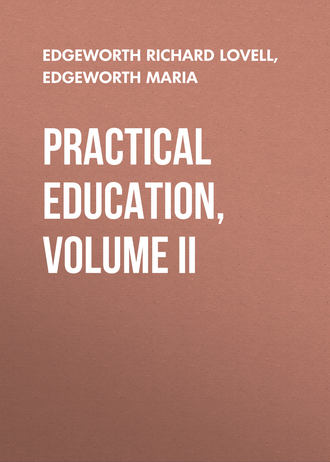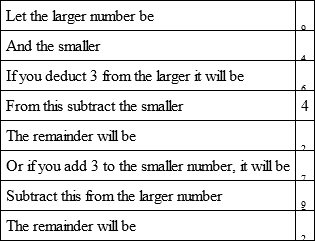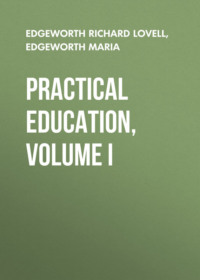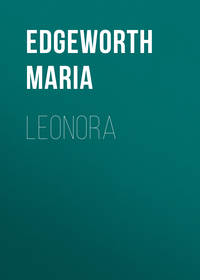 полная версия
полная версияPractical Education, Volume II
As soon as distinct notions have been acquired of the manner in which a collection of ten units becomes a new unit of a higher order, our pupil may be led to observe the utility of this invention by various examples, before he applies it to the rules of arithmetic. Let him count as far as ten with black pebbles,17 for instance; let him lay aside a white pebble to represent the collection of ten; he may count another series of ten black pebbles, and lay aside another white one; and so on, till he has collected ten white pebbles: as each of the ten white pebbles represents ten black pebbles, he will have counted one hundred; and the ten white pebbles may now be represented by a single red one, which will stand for one hundred. This large number, which it takes up so much time to count, and which could not be comprehended at one view, is represented by a single sign. Here the difference of colour forms the distinction: difference in shape, or size, would answer the same purpose, as in the Roman notation X for ten, L for fifty, C for one hundred, &c. All this is fully within the comprehension of a child of six years old, and will lead him to the value of written figures by the place which they hold when compared with one another. Indeed he may be led to invent this arrangement, a circumstance which would encourage him in every part of his education. When once he clearly comprehends that the third place, counting from the right, contains only figures which represent hundreds, &c. he will have conquered one of the greatest difficulties of arithmetic. If a paper ruled with several perpendicular lines, a quarter of an inch asunder, be shown to him, he will see that the spaces or columns between these lines would distinguish the value of figures written in them, without the use of the sign (0) and he will see that (0) or zero, serves only to mark the place or situation of the neighbouring figures.
An idea of decimal arithmetic, but without detail, may now be given to him, as it will not appear extraordinary to him that a unit should represent ten by having its place, or column changed; and nothing more is necessary in decimal arithmetic, than to consider that figure which represented, at one time, an integer, or whole, as representing at another time the number of tenth parts into which that whole may have been broken.
Our pupil may next be taught what is called numeration, which he cannot fail to understand, and in which he should be frequently exercised. Common addition will be easily understood by a child who distinctly perceives that the perpendicular columns, or places in which figures are written, may distinguish their value under various different denominations, as gallons, furlongs, shillings, &c. We should not tease children with long sums in avoirdupois weight, or load their frail memories with tables of long-measure, and dry-measure, and ale-measure in the country, and ale-measure in London; only let them cast up a few sums in different denominations, with the tables before them, and let the practice of addition be preserved in their minds by short sums every day, and when they are between six and seven years old, they will be sufficiently masters of the first and most useful rule of arithmetic.
To children who have been trained in this manner, subtraction will be quite easy; care, however, should be taken to give them a clear notion of the mystery of borrowing and paying, which is inculcated in teaching subtraction.

"Six from four I can't, but six from ten, and four remains; four and four is eight."
And then, "One that I borrowed and four are five, five from nine, and four remains."
This is the formula; but is it ever explained – or can it be? Certainly not without some alteration. A child sees that six cannot be subtracted (taken) from four: more especially a child who is familiarly acquainted with the component parts of the names six and four: he sees that the sum 46 is less than the sum 94, and he knows that the lesser sum may be subtracted from the greater; but he does not perceive the means of separating them figure by figure. Tell him, that though six cannot be deducted from four, yet it can from fourteen, and that if one of the tens which are contained in the (9) ninety in the uppermost row of the second column, be supposed to be taken away, or borrowed, from the ninety, and added to the four, the nine will be reduced to 8 (eighty), and the four will become fourteen. Our pupil will comprehend this most readily; he will see that 6, which could not be subtracted from 4, may be subtracted from fourteen, and he will remember that the 9 in the next column is to be considered as only (8). To avoid confusion, he may draw a stroke across the (9) and write 8 over18 it [8 over (9)] and proceed to the remainder of the operation. This method for beginners is certainly very distinct, and may for some time, be employed with advantage; and after its rationale has become familiar, we may explain the common method which depends upon this consideration.
"If one number is to be deducted from another, the remainder will be the same, whether we add any given number to the smaller number, or take away the same given number from the larger." For instance:

Now in the common method of subtraction, the one which is borrowed is taken from the uppermost figure in the adjoining column, and instead of altering that figure to one less, we add one to the lowest figure, which, as we have just shown, will have the same effect. The terms, however, that are commonly used in performing this operation, are improper. To say "one that I borrowed, and four" (meaning the lowest figure in the adjoining column) implies the idea that what was borrowed is now to be repaid to that lowest figure, which is not the fact. As to multiplication, we have little to say. Our pupil should be furnished, in the first instance, with a table containing the addition of the different units, which form the different products of the multiplication table: these he should, from time to time, add up as an exercise in addition; and it should be frequently pointed out to him, that adding these figures so many times over, is the same as multiplying them by the number of times that they are added; as three times 3 means 3 added three times. Here one of the figures represents a quantity, the other does not represent a quantity, it denotes nothing but the times, or frequency of repetition. Young people, as they advance, are apt to confound these signs, and to imagine, for instance, in the rule of three, &c. that the sums which they multiply together, mean quantities; that 40 yards of linen may be multiplied by three and six-pence, &c. – an idea from which the misstatements in sums that are intricate, frequently arise.
We have heard that the multiplication table has been set, like the Chapter of Kings, to a cheerful tune. This is a species of technical memory which we have long practised, and which can do no harm to the understanding; it prevents the mind from no beneficial exertion, and may save much irksome labour. It is certainly to be wished, that our pupil should be expert in the multiplication table; if the cubes which we have formerly mentioned, be employed for this purpose, the notion of squaring figures will be introduced at the same time that the multiplication table is committed to memory.
In division, what is called the Italian method of arranging the divisor and quotient, appears to be preferable to the common one, as it places them in such a manner as to be easily multiplied by each other, and as it agrees with algebraic notation.
The usual method is this:

Italian method:

The rule of three is commonly taught in a manner merely technical: that it may be learned in this manner, so as to answer the common purposes of life, there can be no doubt; and nothing is further from our design, than to depreciate any mode of instruction which has been sanctioned by experience: but our purpose is to point out methods of conveying instruction that shall improve the reasoning faculty, and habituate our pupil to think upon every subject. We wish, therefore, to point out the course which the mind would follow to solve problems relative to proportion without the rule, and to turn our pupil's attention to the circumstances in which the rule assists us.
The calculation of the price of any commodity, or the measure of any quantity, where the first term is one, may be always stated as a sum in the rule of three; but as this statement retards, instead of expediting the operation, it is never practised.
If one yard costs a shilling, how much will three yards cost?
The mind immediately perceives, that the price added three times together, or multiplied by three, gives the answer. If a certain number of apples are to be equally distributed amongst a certain number of boys, if the share of one is one apple, the share of ten or twenty is plainly equal to ten or twenty. But if we state that the share of three boys is twelve apples, and ask what number will be sufficient for nine boys, the answer is not obvious; it requires consideration. Ask our pupil what made it so easy to answer the last question, he will readily say, "Because I knew what was the share of one."
Then you could answer this new question if you knew the share of one boy?
Yes.
Cannot you find out what the share of one boy is when the share of three boys is twelve?
Four.
What number of apples then will be enough, at the same rate, for nine boys?
Nine times four, that is thirty-six.
In this process he does nothing more than divide the second number by the first, and multiply the quotient by the third; 12 divided by 3 is 4, which multiplied by 9 is 36. And this is, in truth, the foundation of the rule; for though the golden rule facilitates calculation, and contributes admirably to our convenience, it is not absolutely necessary to the solution of questions relating to proportion.
Again, "If the share of three boys is five apples, how many will be sufficient for nine?"
Our pupil will attempt to proceed as in the former question, and will begin by endeavouring to find out the share of one of the three boys; but this is not quite so easy; he will see that each is to have one apple, and part of another; but it will cost him some pains to determine exactly how much. When at length he finds that one and two-thirds is the share of one boy, before he can answer the question, he must multiply one and two-thirds by nine, which is an operation in fractions, a rule of which he at present knows nothing. But if he begins by multiplying the second, instead of dividing it previously by the first number, he will avoid the embarrassment occasioned by fractional parts, and will easily solve the question.

which product 45, divided by 3, gives 15.
Here our pupil perceives, that if a given number, 12, for instance, is to be divided by one number, and multiplied by another, it will come to the same thing, whether he begins by dividing the given number, or by multiplying it.
12 divided by 4 is 3, which
multiplied by 6 is 18;
And
12 multiplied by 6 is 72, which
divided by 4 is 18.
We recommend it to preceptors not to fatigue the memories of their young pupils with sums which are difficult only from the number of figures which they require, but rather to give examples in practice, where aliquot parts are to be considered, and where their ingenuity may be employed without exhausting their patience. A variety of arithmetical questions occur in common conversation, and from common incidents; these should be made a subject of inquiry, and our pupils, amongst others, should try their skill: in short, whatever can be taught in conversation, is clear gain in instruction.
We should observe, that every explanation upon these subjects should be recurred to from time to time, perhaps every two or three months; as there are no circumstances in the business of every day, which recall abstract speculations to the minds of children; and the pupil who understands them to-day, may, without any deficiency of memory, forget them entirely in a few weeks. Indeed, the perception of the chain of reasoning, which connects demonstration, is what makes it truly advantageous in education. Whoever has occasion, in the business of life, to make use of the rule of three, may learn it effectually in a month as well as in ten years; but the habit of reasoning cannot be acquired late in life without unusual labour, and uncommon fortitude.
CHAPTER XVI
GEOMETRYThere is certainly no royal road to geometry, but the way may be rendered easy and pleasant by timely preparations for the journey.
Without any previous knowledge of the country, or of its peculiar language, how can we expect that our young traveller should advance with facility or pleasure? We are anxious that our pupil should acquire a taste for accurate reasoning, and we resort to Geometry, as the most perfect, and the purest series of ratiocination which has been invented. Let us, then, sedulously avoid whatever may disgust him; let his first steps be easy, and successful; let them be frequently repeated until he can trace them without a guide.
We have recommended in the chapter upon Toys, that children should, from their earliest years, be accustomed to the shape of what are commonly called regular solids; they should also be accustomed to the figures in mathematical diagrams. To these should be added their respective names, and the whole language of the science should be rendered as familiar as possible.
Mr. Donne, an ingenious mathematician of Bristol, has published a prospectus of an Essay on Mechanical Geometry: he has executed, and employed with success, models in wood and metal for demonstrating propositions in geometry in a palpable manner. We have endeavoured, in vain, to procure a set of these models for our own pupils, but we have no doubt of their entire utility.
What has been acquired in childhood, should not be suffered to escape the memory. Dionysius19 had mathematical diagrams described upon the floors of his apartments, and thus recalled their demonstrations to his memory. The slightest addition that can be conceived, if it be continued daily, will imperceptibly, not only preserve what has been already acquired, but will, in a few years, amount to as large a stock of mathematical knowledge as we could wish. It is not our object to make mathematicians, but to make it easy to our pupil to become a mathematician, if his interest, or his ambition, make it desirable; and, above all, to habituate him to clear reasoning, and close attention. And we may here remark, that an early acquaintance with the accuracy of mathematical demonstration, does not, within our experience, contract the powers of the imagination. On the contrary, we think that a young lady of twelve years old, who is now no more, and who had an uncommon propensity to mathematical reasoning, had an imagination remarkably vivid and inventive.20
We have accustomed our pupils to form in their minds the conception of figures generated from points and lines, and surfaces supposed to move in different directions, and with different velocities. It may be thought, that this would be a difficult occupation for young minds; but, upon trial, it will be found not only easy to them, but entertaining. In their subsequent studies, it will be of material advantage; it will facilitate their progress not only in pure mathematics, but in mechanics and astronomy, and in every operation of the mind which requires exact reflection.
To demand steady thought from a person who has not been trained to it, is one of the most unprofitable and dangerous requisitions that can be made in education.
"Full in the midst of Euclid dip at once,And petrify a genius to a dunce."In the usual commencement of mathematical studies, the learner is required to admit that a point, of which he sees the prototype, a dot before him, has neither length, breadth, nor thickness. This, surely, is a degree of faith not absolutely necessary for the neophyte in science. It is an absurdity which has, with much success, been attacked in "Observations on the Nature of Demonstrative Evidence," by Doctor Beddoes.
We agree with the doctor as to the impropriety of calling a visible dot, a point without dimensions. But, notwithstanding the high respect which the author commands by a steady pursuit of truth on all subjects of human knowledge, we cannot avoid protesting against part of the doctrine which he has endeavoured to inculcate. That the names point, radius, &c. are derived from sensible objects, need not be disputed; but surely the word centre can be understood by the human mind without the presence of any visible or tangible substance.
Where two lines meet, their junction cannot have dimensions; where two radii of a circle meet, they constitute the centre, and the name centre may be used for ever without any relation to a tangible or visible point. The word boundary, in like manner, means the extreme limit we call a line; but to assert that it has thickness, would, from the very terms which are used to describe it, be a direct contradiction. Bishop Berkely, Mr. Walton, Philathetes Cantabrigiensis, and Mr. Benjamin Robins, published several pamphlets upon this subject about half a century ago. No man had a more penetrating mind than Berkely; but we apprehend that Mr. Robins closed the dispute against him. This is not meant as an appeal to authority, but to apprize such of our readers as wish to consider the argument, where they may meet an accurate investigation of the subject. It is sufficient for our purpose, to warn preceptors not to insist upon their pupils' acquiescence in the dogma, that a point, represented by a dot, is without dimensions; and at the same time to profess, that we understand distinctly what is meant by mathematicians when they speak of length without breadth, and of a superfices without depth; expressions which, to our minds, convey a meaning as distinct as the name of any visible or tangible substance in nature, whose varieties from shade, distance, colour, smoothness, heat, &c. are infinite, and not to be comprehended in any definition.
In fact, this is a dispute merely about words, and as the extension of the art of printing puts it in the power of every man to propose and to defend his opinions at length, and at leisure, the best friends may support different sides of a question with mutual regard, and the most violent enemies with civility and decorum. Can we believe that Tycho Brahe lost half his nose in a dispute with a Danish nobleman about a mathematical demonstration?
CHAPTER XVII
ON MECHANICSParents are anxious that children should be conversant with Mechanics, and with what are called the Mechanic Powers. Certainly no species of knowledge is better suited to the taste and capacity of youth, and yet it seldom forms a part of early instruction. Every body talks of the lever, the wedge, and the pulley, but most people perceive, that the notions which they have of their respective uses, are unsatisfactory, and indistinct; and many endeavour, at a late period of life, to acquire a scientific and exact knowledge of the effects that are produced by implements which are in every body's hands, or that are absolutely necessary in the daily occupations of mankind.
An itinerant lecturer seldom fails of having a numerous and attentive auditory; and if he does not communicate much of that knowledge which he endeavours to explain, it is not to be attributed either to his want of skill, or to the insufficiency of his apparatus, but to the novelty of the terms which he is obliged to use. Ignorance of the language in which any science is taught, is an insuperable bar to its being suddenly acquired; besides a precise knowledge of the meaning of terms, we must have an instantaneous idea excited in our minds whenever they are repeated; and, as this can be acquired only by practice, it is impossible that philosophical lectures can be of much service to those who are not familiarly acquainted with the technical language in which they are delivered; and yet there is scarcely any subject of human inquiry more obvious to the understanding, than the laws of mechanics. Only a small portion of geometry is necessary to the learner, if he even wishes to become master of the more difficult problems which are usually contained in a course of lectures, and most of what is practically useful, may be acquired by any person who is expert in common arithmetic.
But we cannot proceed a single step without deviating from common language; if the theory of the balance, or the lever, is to be explained, we immediately speak of space and time. To persons not versed in literature, it is probable that these terms appear more simple and unintelligible than they do to a man who has read Locke, and other metaphysical writers. The term space to the bulk of mankind, conveys the idea of an interval; they consider the word time as representing a definite number of years, days, or minutes; but the metaphysician, when he hears the words space and time, immediately takes the alarm, and recurs to the abstract notions which are associated with these terms; he perceives difficulties unknown to the unlearned, and feels a confusion of ideas which distracts his attention. The lecturer proceeds with confidence, never supposing that his audience can be puzzled by such common terms. He means by space, the distance from the place whence a body begins to fall, to the place where its motion ceases; and by time, he means the number of seconds, or of any determinate divisions of civil time which elapse from the commencement of any motion to its end; or, in other words, the duration of any given motion. After this has been frequently repeated, any intelligent person perceives the sense in which they are used by the tenour of the discourse; but in the interim, the greatest part of what he has heard, cannot have been understood, and the premises upon which every subsequent demonstration is founded, are unknown to him. If this be true, when it is affirmed of two terms only, what must be the situation of those to whom eight or ten unknown technical terms occur at the commencement of a lecture? A complete knowledge, such a knowledge as is not only full, but familiar, of all the common terms made use of in theoretic and practical mechanics, is, therefore, absolutely necessary before any person can attend public lectures in natural philosophy with advantage.
What has been said of public lectures, may, with equal propriety, be applied to private instruction; and it is probable, that inattention to this circumstance is the reason why so few people have distinct notions of natural philosophy. Learning by rote, or even reading repeatedly, definitions of the technical terms of any science, must undoubtedly facilitate its acquirement; but conversation, with the habit of explaining the meaning of words, and the structure of common domestic implements, to children, is the sure and effectual method of preparing the mind for the acquirement of science.
The ancients, in learning this species of knowledge, had an advantage of which we are deprived: many of their terms of science were the common names of familiar objects. How few do we meet who have a distinct notion of the words radius, angle, or valve. A Roman peasant knew what a radius or a valve meant, in their original signification, as well as a modern professor; he knew that a valve was a door, and a radius a spoke of a wheel; but an English child finds it as difficult to remember the meaning of the word angle, as the word parabola. An angle is usually confounded, by those who are ignorant of geometry and mechanics, with the word triangle, and the long reasoning of many a laborious instructer has been confounded by this popular mistake. When a glass pump is shown to an admiring spectator, he is desired to watch the motion of the valves: he looks "above, about, and underneath;" but, ignorant of the word valve, he looks in vain. Had he been desired to look at the motion of the little doors that opened and shut, as the handle of the pump was moved up and down, he would have followed the lecturer with ease, and would have understood all his subsequent reasoning. If a child attempts to push any thing heavier than himself, his feet slide away from it, and the object can be moved only at intervals, and by sudden starts; but if he be desired to prop his feet against the wall, he finds it easy to push what before eluded his little strength. Here the use of a fulcrum, or fixed point, by means of which bodies may be moved, is distinctly understood. If two boys lay a board across a narrow block of wood, or stone, and balance each other at the opposite ends of it, they acquire another idea of a centre of motion. If a poker is rested against a bar of a grate, and employed to lift up the coals, the same notion of a centre is recalled to their minds. If a boy, sitting upon a plank, a sofa, or form, be lifted up by another boy's applying his strength at one end of the seat, whilst the other end of the seat rests on the ground, it will be readily perceived by them, that the point of rest, or centre of motion, or fulcrum, is the ground, and that the fulcrum is not, as in the first instance, between the force that lifts, and the thing that is lifted; the fulcrum is at one end, the force which is exerted acts at the other end, and the weight is in the middle. In trying, these simple experiments, the terms fulcrum, centre of motion, &c. should be constantly employed, and in a very short time they would be as familiar to a boy of eight years old as to any philosopher. If for some years the same words frequently recur to him in the same sense, is it to be supposed that a lecture upon the balance and the lever would be as unintelligible to him as to persons of good abilities, who at a more advanced age hear these terms from the mouth of a lecturer? A boy in such circumstances would appear as if he had a genius for mechanics, when, perhaps, he might have less taste for the science, and less capacity, than the generality of the audience. Trifling as it may at first appear, it will not be found a trifling advantage, in the progress of education, to attend to this circumstance. A distinct knowledge of a few terms, assists a learner in his first attempts; finding these successful, he advances with confidence, and acquires new ideas without difficulty or disgust. Rousseau, with his usual eloquence, has inculcated the necessity of annexing ideas to words; he declaims against the splendid ignorance of men who speak by rote, and who are rich in words amidst the most deplorable poverty of ideas. To store the memory of his pupil with images of things, he is willing to neglect, and leave to hazard, his acquirement of language. It requires no elaborate argument to prove that a boy, whose mind was stored with accurate images of external objects, of experimental knowledge, and who had acquired habitual dexterity, but who was unacquainted with the usual signs by which ideas are expressed, would be incapable of accurate reasoning, or would, at best, reason only upon particulars. Without general terms, he could not abstract; he could not, until his vocabulary was enlarged, and familiar to him, reason upon general topics, or draw conclusions from general principles: in short, he would be in the situation of those who, in the solution of difficult and complicated questions relative to quantity, are obliged to employ tedious and perplexed calculations, instead of the clear and comprehensive methods that unfold themselves by the use of signs in algebra.






